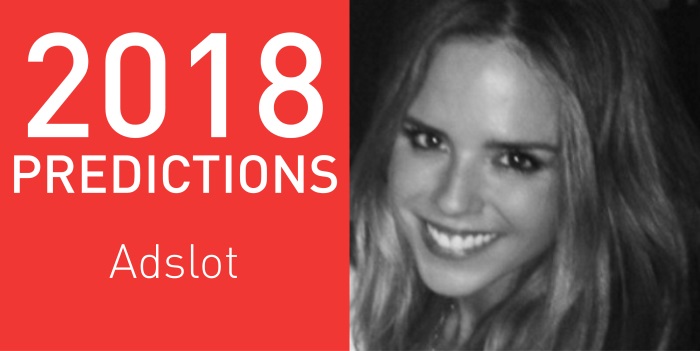Charmagne Jacobs, head of global marketing at Adslot, predicts a year of change for the better in 2018.
 If the advertising industry were to name a word of the year for 2017, much like Time Magazine names its person and Pantone names a color, “programmatic” would certainly be the leading choice. Unfortunately, this is also the year it became synonymous with much more than an action, practice or strategy. It catapulted into the boardroom conversations about brand safety, fraud, transparency and ROI.
If the advertising industry were to name a word of the year for 2017, much like Time Magazine names its person and Pantone names a color, “programmatic” would certainly be the leading choice. Unfortunately, this is also the year it became synonymous with much more than an action, practice or strategy. It catapulted into the boardroom conversations about brand safety, fraud, transparency and ROI.
Advertising and content platforms that have been an important part of advertiser strategy for more than a decade were suddenly seen as dangerous and untrustworthy. It became readily apparent that the media-buying maze has become large and convoluted, and that programmatic buying may not yet be mature enough to handle important, brand-defining campaigns.
The silver lining for 2018 is that change is on the way – in fact, change is being demanded. Marketers now head into a new year with approval to chase goals far more wide-reaching than scale, understanding that 2018 needs to be a year of balance. Balance between what is proven and what is emerging. The trajectory of programmatic may not be forecasted to slow, but a shift is palpable – and it’s exciting. Based on this shift, there are three overarching predictive themes to pay close attention to in the new year.
The balancing act of scale versus safety
Marketers, seeking to balance safety, transparency and scalability with essential first-party data, will assign greater emphasis to placements in premium environments. They will prioritize working with publishers that own the hearts and minds of consumers, with top-of-the-funnel, guaranteed inventory.
While the need for efficiency and reach cannot be overlooked entirely, marketers all the way up to the C-suite must also consider the risks they are assuming for the brand when content lands in the wrong place. Safety has become just as important a consideration as waste. Next year, marketers will pay closer attention to the emerging technology that allows them to scale first-party data with publisher-direct buys, outside of the programmatic pipes. Automated publisher-direct campaigns will help balance the scale in 2018.
The application of more meaningful measurement
Advertising measurement could have its own dictionary of acronyms. ROI, CPMs, ROAS, CPC – but what does any of it mean when the entire ecosystem continues to shift to personalized, one-to-one marketing and content?
According to Asecnd2, the most important objective for martech professionals is increasing ROI (69 per cent). In 2018, arbitrary performance and delivery metrics will roll back to once again make room for the metrics that matter. Marketers will pay closer attention to ROI and meaningful business results, rather than focusing on cost per impressions (CPMs) and arbitrary performance and delivery metrics. Common sense and human insight will be more respected throughout the process, from KPI setting to final campaign assessments.
Publishers aim to win with audience relevance
For anyone who has followed the publisher side of the narrative in 2017, it’s clear they have faced numerous challenges with current business models and offerings. Walled gardens, a digital duopoly and a “race to the bottom,” as observed by Scott Deutrom, chief digital revenue officer at the London Evening Standard and The Independent publisher ESI Media, have pushed publishers to the brink. However, these challenges have sparked fierce innovation. Publishers are pushing back by embracing audience-centric solutions that provide brands with fresh ways to bring the “cool factor” back to brand marketing.
Video, branded content and meaningful online-to-offline experiences are cards programmatic alone cannot throw onto the table. With 66 per cent of marketers ready to remedy their lack of control in relationships with publishers, according to a study from Infectious Media, 2018 will be underscored by marketers re-taking the reins on audience identification and meaningful engagement. Further supporting this point, the Society for New Communications Research of the Conference Board found that nearly half of marketers would consider returning to direct relationships with premium, vetted publishers.
2018: far from perfect, but an improvement
At this time next year, we will likely look back on 2017 and, in hindsight, discuss how productive the stumbles and blunders that we saw in 2017 were for the industry as a whole. This was the year where the notion of brand safety and transparency became part of everyone’s pay grade, no matter where they sat in the marketing stack. We learned that set-it-and-forget advertising strategies, albeit tempting, will erode and damage a brand’s reputation in far-reaching ways.
New challenges will surely arise in 2018, and we’re unlikely to untangle the current web anytime soon, but a movement has been set in motion. Marketers will make more balanced decisions that re-establish trust, prioritize ROI and uphold the delivery of exceptional audience experiences above all else.
















